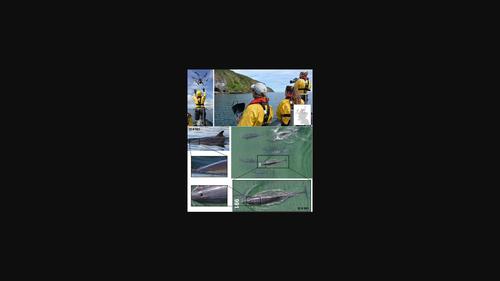当前位置:
X-MOL 学术
›
Remote Sens. Ecol. Conserv.
›
论文详情
Our official English website, www.x-mol.net, welcomes your feedback! (Note: you will need to create a separate account there.)
Spy in the sky: a method to identify pregnant small cetaceans
Remote Sensing in Ecology and Conservation ( IF 5.5 ) Pub Date : 2022-02-08 , DOI: 10.1002/rse2.258 Barbara J. Cheney 1 , Julian Dale 2 , Paul M. Thompson 1 , Nicola J. Quick 2
Remote Sensing in Ecology and Conservation ( IF 5.5 ) Pub Date : 2022-02-08 , DOI: 10.1002/rse2.258 Barbara J. Cheney 1 , Julian Dale 2 , Paul M. Thompson 1 , Nicola J. Quick 2
Affiliation

|
Data on sex ratios, age classes, reproductive success and health status are key metrics to manage populations, yet can be difficult to collect in wild cetacean populations. Long-term individual-based studies provide a unique opportunity to apply unoccupied aerial system (UAS) photogrammetry to non-invasively measure body morphometrics of individuals with known life history information. The aims of this study were (1) to compare length measurements from UAS photogrammetry with laser photogrammetry and (2) to explore whether UAS measurements of body width could be used to remotely determine pregnancy status, sex or age class in a well-studied bottlenose dolphin population in Scotland. We carried out five boat-based surveys in July and August 2017, with concurrent photo-identification, UAS and laser photogrammetry. Photographs were measured using bespoke programmes, MorphMetriX for UAS photos and a Zooniverse project for laser photos. In total 64 dolphins were identified using photo-ID, 54 of which had concurrent UAS body length and 47 with laser body length measurements. We also measured body widths at 10% increments from 10% to 90% of body length for 48 individuals of known sex, age class and/or pregnancy status. There was no significant difference in the length of individuals measured with UAS and laser photogrammetry. Discriminant analyses of the body width–length (WL) ratios expected to change during pregnancy, correctly assigned pregnancy status for 14 of the 15 females of known pregnancy status. Only one pregnant female was incorrectly assigned as not pregnant. However, our results showed that length and body width cannot accurately allocate these bottlenose dolphins to sex or age class using photogrammetry techniques alone. The present study illustrates that UAS and laser photogrammetry measurements are comparable for small cetaceans and demonstrates that UAS measurements of body WL ratio can accurately assign pregnancy status in bottlenose dolphins.
中文翻译:

空中间谍:一种识别怀孕小鲸类动物的方法
有关性别比例、年龄等级、繁殖成功率和健康状况的数据是管理种群的关键指标,但在野生鲸类种群中可能难以收集。长期的基于个体的研究提供了一个独特的机会,可以将无人航空系统 (UAS) 摄影测量应用于非侵入性测量具有已知生活史信息的个体的身体形态测量。本研究的目的是 (1) 比较 UAS 摄影测量与激光摄影测量的长度测量值,以及 (2) 探讨 UAS 测量体宽是否可用于远程确定经过充分研究的宽鼻的妊娠状态、性别或年龄等级苏格兰的海豚种群。我们在 2017 年 7 月和 8 月进行了五次船基调查,同时进行了照片识别、UAS 和激光摄影测量。照片是使用定制程序测量的,用于 UAS 照片的 MorphMetriX 和用于激光照片的 Zooniverse 项目。总共使用照片 ID 识别了 64 只海豚,其中 54 只同时进行了 UAS 体长测量,47 只进行了激光体长测量。我们还以 10% 的增量测量了 48 名已知性别、年龄等级和/或怀孕状态的个体的体宽,从体长的 10% 到 90%。用无人机和激光摄影测量法测量的个体长度没有显着差异。对怀孕期间预期会发生变化的体宽 - 长度 (WL) 比率的判别分析,正确分配了 15 名已知怀孕状态女性中的 14 名的怀孕状态。只有一名怀孕的女性被错误地分配为未怀孕。然而,我们的研究结果表明,仅使用摄影测量技术,无法将这些宽吻海豚准确地分配到性别或年龄级别。本研究表明,UAS 和激光摄影测量测量对于小型鲸类动物具有可比性,并证明身体 WL 比率的 UAS 测量可以准确地确定宽吻海豚的妊娠状态。
更新日期:2022-02-08
中文翻译:

空中间谍:一种识别怀孕小鲸类动物的方法
有关性别比例、年龄等级、繁殖成功率和健康状况的数据是管理种群的关键指标,但在野生鲸类种群中可能难以收集。长期的基于个体的研究提供了一个独特的机会,可以将无人航空系统 (UAS) 摄影测量应用于非侵入性测量具有已知生活史信息的个体的身体形态测量。本研究的目的是 (1) 比较 UAS 摄影测量与激光摄影测量的长度测量值,以及 (2) 探讨 UAS 测量体宽是否可用于远程确定经过充分研究的宽鼻的妊娠状态、性别或年龄等级苏格兰的海豚种群。我们在 2017 年 7 月和 8 月进行了五次船基调查,同时进行了照片识别、UAS 和激光摄影测量。照片是使用定制程序测量的,用于 UAS 照片的 MorphMetriX 和用于激光照片的 Zooniverse 项目。总共使用照片 ID 识别了 64 只海豚,其中 54 只同时进行了 UAS 体长测量,47 只进行了激光体长测量。我们还以 10% 的增量测量了 48 名已知性别、年龄等级和/或怀孕状态的个体的体宽,从体长的 10% 到 90%。用无人机和激光摄影测量法测量的个体长度没有显着差异。对怀孕期间预期会发生变化的体宽 - 长度 (WL) 比率的判别分析,正确分配了 15 名已知怀孕状态女性中的 14 名的怀孕状态。只有一名怀孕的女性被错误地分配为未怀孕。然而,我们的研究结果表明,仅使用摄影测量技术,无法将这些宽吻海豚准确地分配到性别或年龄级别。本研究表明,UAS 和激光摄影测量测量对于小型鲸类动物具有可比性,并证明身体 WL 比率的 UAS 测量可以准确地确定宽吻海豚的妊娠状态。



























 京公网安备 11010802027423号
京公网安备 11010802027423号